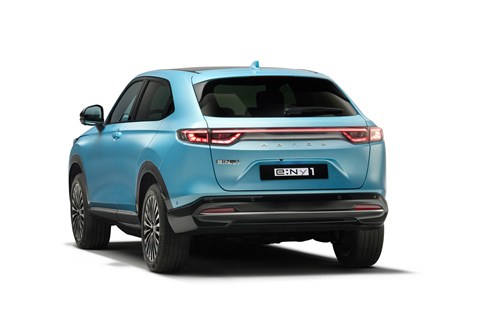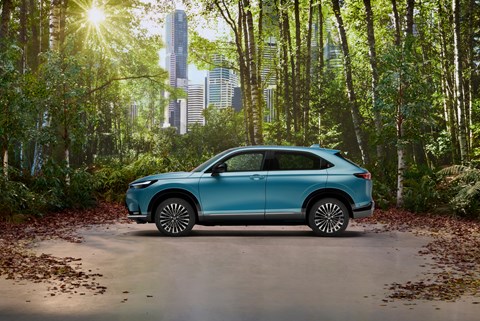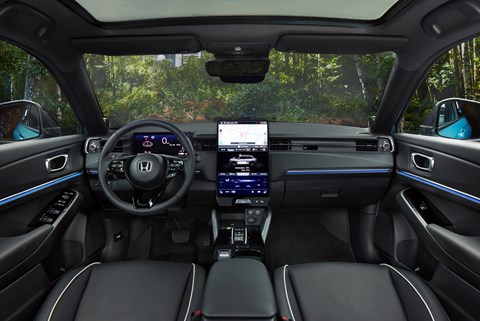► Honda unveils its second electric car
► More practical offering than the Honda e
► Introduces new intelligent charging system
Honda is finally starting to expand its electric car range with this – the new e:Ny1 SUV. The Japanese brand is somewhat of a latecomer to the party. Until now, the only fully electric car the company has launched is the Honda e – but that’s more of a fashion accessory than a credible electric family car.
The Honda e:Ny1 seeks to change that. It’ll lay the foundations for the company’s ambitious plan to launch 30 new electric vehicles by 2030, wading into the hotly contested B-segment SUV market where it’ll rival the likes of the Kia Niro EV, Mercedes EQA and Volvo XC40 Electric. It also promises to be much more practical than the Honda e, in terms of both its luggage capacity and its range.
What’s powering the Honda e:Ny1?
The SUV is propped up by Honda’s e:N Architecture F. It’s an all-new platform with a 68.8kWh battery pack bolted under the floor and a 150kW (201bhp) electric motor mounted to the front axle. Honda says the system has a maximum range of 256 miles. That’s decidedly average, but the firm’s executives don’t seem particularly bothered by the fact this new SUV isn’t as long-legged as the Tesla Model Y. They’re comfortable with the idea the e:Ny1 will be mainly used for local journeys.
Charge times are equally average. The e:Ny1’s platform can only accept a maximum DC charging speed of 78kW, which is eons behind the 350kW charging system fitted to the Kia EV6 and Hyundai Ioniq 5. That means it takes the Honda 45 minutes to charge from 10–80% capacity instead of just 18 minutes in the Kia and Hyundai.

Tom Gardner, Senior Vice President of Honda Motor Europe, said: ‘We believe the e:Ny1 delivers that packaging of QCD (quality cost and delivery) that customer expectation is there for the price. So, we’re working on that aspect of it and balancing many different variables in terms of engineering to deliver that.
‘You mentioned the charging time, we think in terms of the usage at the product that will be acceptable to the customer. So again, we looking at a lot of markets, we’re doing a lot of studies at how people are charging products – and we’re spending a lot of time at charging stations, actually –watching people charging and noticing the fact that people don’t spend a lot of time there.
‘They’re just asking for a couple of extra 100 kilometres and then they’re continuing their journeys. So that’s the key. So actually – is 300 kilowatts, the necessary point and price of charging station electricity. Is that balance again, isn’t it? Again 87kW [charging speeds] we think is the right target point that the customer at the moment.’
Jorgen Pluym, Honda’s head of Energy Solutions, backed this sentiment up, saying: Personally, I always call fast-charging emergency charging. I think no one is really happy with that kind of charging. It’s not good for the grid because you need to take a huge peak in power; it’s basically not good for your battery and the cost is very high. So, that’s why we think – at least for those people who have the possibility to charge from home – we think that will be the dominant charging solution.

Honda hopes to compensate for the e:Ny1’s rather average range figure with its natty e:Progress charge management system. The company says the tech can save its EV drivers money while also helping to reduce their carbon footprint. The technology is still in its trial phase, but Honda aims to have it on the market within the next couple of years.
The system is based around a bi-directional smart charging hub, which can monitor the status of the electricity grid. If the grid has a surplus amount of energy, the hub will charge the car connected to it. If the grid is in a power deficit, the hub will siphon power off the car and either sell it back to the grid or use it to power the building it’s connected to.
When the technology is in widespread use, Honda says this intelligent charging management will help to chop the top off daily power peaks and prevent blackouts from over-exerting the electricity grid. Honda also reckons the system could slash between £400 and £500 off its customers’ yearly energy bills – and high mileage drivers might claw back as much as £1000.
The e:Progress charge management system can also chop massive lumps out of each owner’s carbon emissions, especially when paired with a green energy tariff.
Is the interior any good?

We’ve seen the e:Ny1 in the studio – and we were a little underwhelmed by it. The build quality doesn’t feel anywhere near as good as the Honda e’s and there are some glaring practicality oversights. Take the roofline. It tapers sharply towards the tailgate, hacking a chunk out of the door aperture on the way. That means you bash your head into the C-pillar every time you step into the rear of the car.
Despite the e:Ny1’s design similarities to the HR-V, Honda has also elected to ditch the latter car’s excellent physical buttons. Instead, most of the e:Ny1’s cabin functions have been moved onto a 15.1-inch portrait infotainment screen, a third of which is reserved for the climate controls. It certainly looks swanky but we can see it being frustrating to operate on the move.